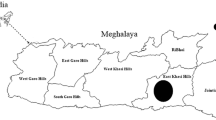Abstract
Three categories of secondary successional herbaceous communities subsequent ot slash and burn, viz., early successional non-sprouting, early successional sprouting and late successional populations were investigated for their reproductive efficiency considering leaf component since it is the chief organ of photosynthesis. Early successional non-sprouting populations were found to be reproductively the most efficient whereas the early successional sprouting populations allocated more to vegetatively reproducing organs. While the high reproductive potential of early successional non-sprouting species was associated with vigour and production efficiency of the species, this relationship was stronger with the latter characteristic. On the other hand, early successional sprouting populations showed inverse relationship between vegetative and sexual reproductive effort. The strategy of late successional species seems to be to maximize vegetative growth in a closed habitat. The significance of these strategies is discussed in the paper.
Similar content being viewed by others
References
Abrahamson W G 1975 Reproductive strategies in dewberries;Ecology 56 721–726
Abrahamson W G 1979 Patterns of resource allocation in wildflower populations of fields and woods;Am. J. Bot. 66 71–79
Abrahamson W G and Gadgil M 1973 Growth and reproductive effort in golden rods (Solidago, Compositae);Am. Nat. 107 651–661
Bazzaz F A and Harper J L 1977 Demographic analysis of the growth ofLinum usitatissimum;New Phytol. 78 193–208
Evans G C 1972The quantitative analysis of plant growth (Oxford: Blackwell Scientific Publications)
Gill A M 1975 Fire and the Australian flora: a review;Aust. For. 38 4–25
Grime J P 1974 Vegetation classification by reference to strategies;Nature (London) 250 26–31
Grime J P 1977 Evidence for the existence of three primary strategies in plants and its relevance to ecological and evolutionary theory;Am. Nat. 111 1169–1194
Harper J L 1977The population biology of plants (San Francisco: Academic Press)
Harper J L and Ogden J 1970 The reproductive strategies of higher plants. I. The concept of strategy with special reference toSenecio vulgaris L.;J. Ecol. 58 681–698
MacArthur R H and Wilson E O 1967The theory of island biogeography (Princeton NJ Princeton University Press)
Misra R 1968Ecology workbook (New Delhi: Oxford and IBH Publication)
McNaughton S J 1975r- andK-selection inTypha;Am. Nat. 109 251–261
Myerscough P J and Whitehead F H 1967 Comparative biology ofTussilago farfara L.,Chamaenerion angustifolium (L.) Scop.,Epilobium montanum L. andEpilobium adenocaulon Hauskon. II. Growth and ecology;New Phytol. 66 785–823
Newell S J and Tramer E J 1978 Reproductive strategies in herbaceous plant communities during succession;Ecology 59 228–234
Ogden J 1974 The reproductive strategy of higher plants. II. The reproductive strategy ofTussilago farfara L.;J. Ecol. 61 291–324
Primack R B 1979 Reproductive effort in annual and perennial species ofPlantago (Plantaginaceae);Am. Nat. 114 51–62
Ramakrishnan P S, Toky O P, Mishra B K and Saxena K G 1981 Slash and burn agriculture in north-eastern India; InFire regimes and ecosystem properties (eds.) H A Mooney, J M Bonnicksen, N L Christensen, J E Lotan and W A Reiners.USDA For. Serv. Gen. Tech. Rep. pp. 560–584
Wilson M F 1971 Life history consequences of death rates;Biologist (Phil. Sigma Soc.) 53 49–56
Author information
Authors and Affiliations
Rights and permissions
About this article
Cite this article
Saxena, K.G., Ramakrishnan, P.S. Reproductive efficiency of secondary successional herbaceous population subsequent to slash and burn of sub-tropical humid forests in north-eastern India. Proc. Indian Acad. Sci. 91, 61–68 (1982). https://doi.org/10.1007/BF03052964
Received:
Revised:
Issue Date:
DOI: https://doi.org/10.1007/BF03052964




